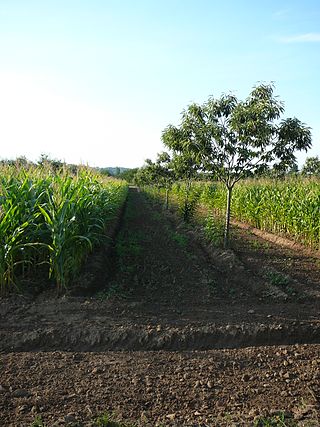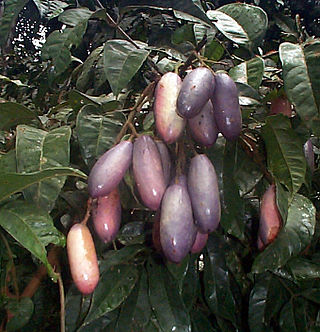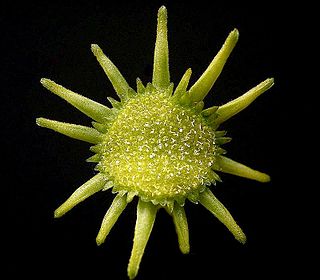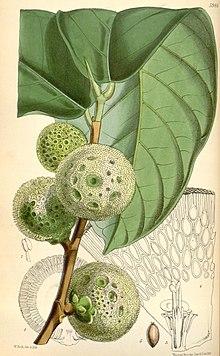
Mangifera is a genus of flowering plants in the cashew family, Anacardiaceae. It contains about 69 species, with the best-known being the common mango. The center of diversity of the genus is in the Malesian ecoregion of Southeast Asia, particularly in Sumatra, Borneo, and the Malay Peninsula. They are generally canopy trees in lowland rainforests, reaching a height of 30–40 m (98–131 ft).

The Moraceae—often called the mulberry family or fig family—are a family of flowering plants comprising about 38 genera and over 1100 species. Most are widespread in tropical and subtropical regions, less so in temperate climates; however, their distribution is cosmopolitan overall. The only synapomorphy within the Moraceae is presence of laticifers and milky sap in all parenchymatous tissues, but generally useful field characters include two carpels sometimes with one reduced, compound inconspicuous flowers, and compound fruits. The family includes well-known plants such as the fig, banyan, breadfruit, jackfruit, mulberry, and Osage orange. The 'flowers' of Moraceae are often pseudanthia.

Amorphophallus is a large genus of some 200 tropical and subtropical tuberous herbaceous plants from the Arum family (Araceae), native to Asia, Africa, Australia and various oceanic islands. A few species are edible as "famine foods" after careful preparation to remove irritating chemicals. The genus includes the Titan arum of Indonesia, which has the largest inflorescence of any plant in the genus, and is also known as the 'corpse flower' for the pungent odour it produces during its flowering period, which can take up through seven years of growth before it occurs.

Cecropia is a Neotropical genus consisting of 61 recognized species with a highly distinctive lineage of dioecious trees. The genus consists of pioneer trees in the more or less humid parts of the Neotropics, with the majority of the species being myrmecophytic. Berg and Rosselli state that the genus is characterized by some unusual traits: spathes fully enclosing the flower-bearing parts of the inflorescences until anthesis, patches of dense indumentums (trichilia) producing Mullerian (food) at the base of the petiole, and anthers becoming detached at anthesis. Cecropia is most studied for its ecological role and association with ants. Its classification is controversial; in the past, it has been placed in the Cecropiaceae, Moraceae, or Urticaceae. The modern Angiosperm Phylogeny Group system places the "cecropiacean" group in the Urticaceae.

Celtis is a genus of about 60–70 species of deciduous trees, commonly known as hackberries or nettle trees, widespread in warm temperate regions of the Northern Hemisphere. The genus is part of the extended Cannabis family (Cannabaceae).

Agroforestry is a land use management system that integrates trees with crops or pasture. It combines agricultural and forestry technologies. As a polyculture system, an agroforestry system can produce timber and wood products, fruits, nuts, other edible plant products, edible mushrooms, medicinal plants, ornamental plants, animals and animal products, and other products from both domesticated and wild species.

Maclura is a genus of flowering plants in the mulberry family, Moraceae. It includes the inedible Osage orange, which is used as mosquito repellent and grown throughout the United States as a hedging plant. It is dioecious, with male and female flowers borne on separate plants.

The genus of the myrrhs, Commiphora, is the most species-rich genus of flowering plants in the frankincense and myrrh family, Burseraceae. The genus contains approximately 190 species of shrubs and trees, which are distributed throughout the (sub-) tropical regions of Africa, the western Indian Ocean islands, the Arabian Peninsula, India, and South America. The genus is drought-tolerant and common throughout the xerophytic scrub, seasonally dry tropical forests, and woodlands of these regions.

Brosimum alicastrum, commonly known as breadnut, Maya nut or ramon, and many others, is a tree species in the family Moraceae of flowering plants, whose other genera include figs and mulberries. The plant is known by a range of names in indigenous Mesoamerican and other languages, including: ojoche, ojite, ojushte, ujushte, ujuxte, capomo, mojo, ox, iximche, masica in Honduras, uje in the state of Michoacan Mexico, mojote in Jalisco, chokogou in Haitian Creole and chataigne in Trinidadian Creole. In the Caribbean coast of Colombia it is called guaímaro or guaymaro.

Joseph Decaisne was a French botanist and agronomist. He became an aide-naturaliste to Adrien-Henri de Jussieu (1797-1853), who served as the chair of rural botany. It was during this time that he began to study plants brought back by various travelers like those of Victor Jacquemont (1801-1832) from Asia. Decaisne used applied research, most notably on the agronomy of the madder, the yam and the ramie. He was also interested in algae.

Dacryodes edulis is a fruit tree in the Burseraceae family native to Africa. Its various regional names include safou, messa, plum (Cameroon), atanga, ube, elumi (Nigeria), African pear, bush pear, African plum, nsafu, bush butter tree, or butterfruit.
Pseudolmedia is a flowering plant genus in the mulberry family (Moraceae). Species are found in southern Mexico, the Caribbean, and Meso- and South America. They are known in Latin America as lechechiva and used for timber, construction wood, and sometimes in folk medicine.

Antiaris toxicaria is a tree in the mulberry and fig family, Moraceae. It is the only species currently recognized in the genus Antiaris. The genus Antiaris was at one time considered to consist of several species, but is now regarded as just one variable species which can be further divided into five subspecies. One significant difference within the species is that the size of the fruit decreases as one travels from Africa to Polynesia. Antiaris has a remarkably wide distribution in tropical regions, occurring in Australia, tropical Asia, tropical Africa, Indonesia, the Philippines, Tonga, and various other tropical islands. Its seeds are spread by various birds and bats, and it is not clear how many of the populations are essentially invasive. The species is of interest as a source of wood, bark cloth, and pharmacological or toxic substances.

Dorstenia is a genus within the mulberry family, Moraceae. Depending on the author, there are said to be 100 to 170 species within this genus, second only in number to the genus Ficus within Moraceae. Plants of the World Online currently accepts 122 species. Dorstenia species are mainly known for their unusual inflorescences and growth habits. Dorstenia is named in honor of the German physician and botanist Theodor Dorsten (1492–1552). The type species is Dorstenia contrajerva.

Treculia africana is a tree species in the genus Treculia which can be used as a food plant and for various other traditional uses. The fruits are hard and fibrous, can be the size of a volleyball and weight up to 8.5 kg (19 lb). Chimpanzees have been observed to use tools to break the fruits into small pieces that they can eat. The fruits contain polyphenols.
Lasiosiphon is a genus of flowering plants belonging to the family Thymelaeaceae.














